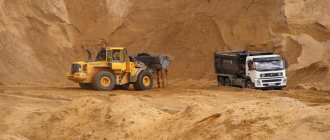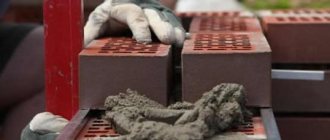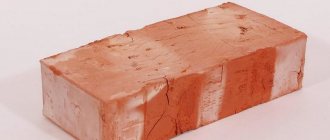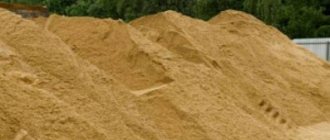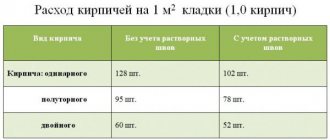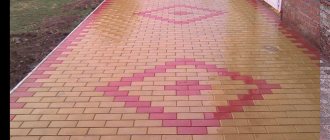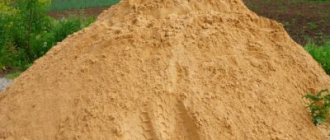What sand is suitable for bricklaying?
Masonry mortar directly affects the convenience of work, and also plays an important role in shaping the final properties of brickwork. Hence the need to carefully select components, otherwise you can get a dubious result.
Why is there sand in the solution?
Before determining which sand is best suited for bricklaying, let’s find out its functions in the mortar.
The loads that the mortar in the masonry resists are quite uniform and stable. There is almost no impact on rupture. These circumstances make it possible to use relatively simple mortars for masonry, in which the content of binder (cement or lime) may be low. Sand is a filler and occupies the main share of the solution (3 quarters, or even 5 sixths). Its task is as follows:
- Regulation of solution volume;
- Reduced shrinkage;
- Compensation for unevenness of bricks to ensure evenness of the masonry.
In addition, sand affects the appearance of the mortar, which is important for decorative finishing.
Sand is used as a filler because it has a number of useful properties in this case:
- Chemical inertness;
- Relatively homogeneous structure;
- Resistant to loads and mechanical strength;
- Accessibility (both physically and financially).
Sand selection
Let's consider what kind of sand is needed for laying bricks.
To begin with, it is important for us that the sand is free of unnecessary impurities. The properties of the solution will be especially strongly affected by clay impurities, which do not allow water to pass through, which leads to the formation of lumps in the solution with very different physical and mechanical properties. They will become the weak point under loads on the solution. However, other pollution is no less harmful.
So, the sand must be clean.
If the sand contains particles of different fractions, the solution will lose homogeneity. The plasticity of the mortar may also deteriorate, which will complicate the alignment of the brick row. In other words, the sand must be sifted to ensure the uniformity of its particles.
Which sand is better for masonry in terms of fraction? The optimal and universal option is medium-fraction sand (particle size 1 – 2 mm). For rough work, you can use a larger fraction, but for decorative finishing it would be more appropriate, on the contrary, to use fine sand.
Origin of sand and its properties
Which sand to use for bricklaying in terms of origin? The mere fact of extracting sand from a quarry or from a river is not important. The important thing is how this affects its properties.
On the one hand, river sand is cleaner and has a more uniform structure. Its particles are polished with water to an almost perfectly spherical state, which increases the attractiveness of its appearance.
On the other hand, such grinding reduces the ability of sand grains to adhere to cement particles and form a monolithic solution. Quarry sand has no such drawback. The career option is also cheaper. But it requires washing and sifting.
Thus, what kind of sand is needed for masonry depends on the type of masonry. For load-bearing walls and rough work, treated quarry sand is the best option.
River sand is more suitable for decorative cladding due to its better appearance.
Which sand is best for construction?
Sand for masonry must be clean and homogeneous; the content of impurities in it has a negative effect. Foreign impurities have a bad effect on the quality of the masonry mortar, reducing the uniformity and plasticity of the composition. Sand of medium fraction is considered ideal for laying bricks, and fine sand is used for decorative finishing.
It’s difficult to say for sure which sand is better. It is preferable to use the river type with particles of the middle fraction. However, grains of sand can be highly polished, which will automatically reduce the adhesion characteristics of the material. In this case, a quarry type is recommended, characterized by a high degree of particle adhesion. Such sand requires additional washing and cleaning to eliminate foreign impurities.
Sand and crushed stone in Moscow region - the lowest prices here!
24-hour sale of sand, crushed stone, concrete with delivery.
- About company
- Delivery areas Solnechnogorsk
- Krasnogorsk
- Zelenograd
- Dmitrov
- Gangway
- Khimki
- Lobnya
- Istra
- Iksha
- Moscow
- Sand Quarry Sand
- Gravel 5x20
- Crushed granite
- Peat
- Rock screening
- Concrete M-100
- Backhoe loader rental
- Asphalting of roads and territories
- Solnechnogorsk
- home
- Reviews
- Photo archive
- Online-Order
- Our fleet
- Promotions and discounts
- Shipping and payment
- Helpful information
- FAQ
Asphalt crumbs
Products
- Sand and crushed stone in bags
- Concrete
- Sand
- Sand Quarry
- Sand Seeded
- Sand River
- Sand Washed
- Sandy soil
- PGS
- OPGS
- Crushed granite
- Crushed stone gravel
- Crushed limestone
- Crushed stone Gabrodiabase
- Gravel 5x20
- Gravel 20x40
- Dropout
- Lawn soil
- Land for sowing
- Soils and fertilizers
- Vegetable soil
- Peat-soil mixture
- "Biocompost cattle"
- Manure-humus
- Tula land
- Chernozem
- Peat
- Asphalt crumbs
- Asphalt
- Cement
- Clay
- Expanded clay
- Broken brick
- Stone. Boulders
- Secondary crushed stone
Construction services
- Improvement and landscaping
- Construction of fences
- Foundation work Foundation for a log house
- Foundation for a garage
- What kind of sand is needed for the foundation?
Site search
News:
- Center for Foreign Languages 01/18/2017
- Soundproofing materials 05/16/2016
- Restoration of old garden paths 04/17/2016
- Warm self-leveling floor. 04/05/2016
- Stair mounting beam 03/09/2016
- Should I lay laminate or linoleum on the floor? 02/26/2016
- Vegetable garden in postmodern style 02/07/2016
- Methods for leveling floors. 02/02/2016
- How to make a warm wooden floor 01/28/2016
- Crushed stone and sand in construction 01/23/2016
- Granite crushed stone 01/22/2016
- Construction of highways 12/23/2015
- Slab foundation 12/21/2015
- Use of granite crushed stone in the construction of foundations 12/15/2015
- Construction of a foundation for building a house in a swampy area 12/15/2015
- Areas of application of peat 09.12.2015
- Repair of a concrete blind area and its installation is the work of the owner 12/08/2015
- Rent a vibrating plate in Solnechnogorsk 12/02/2015
- Crushed stone and gravel 11/08/2015
- Crushed stone and sand in construction 07.11.2015
- Soils and fertilizers 05.15.2015
- PGS and OPGS difference 05/02/2015
- Flakiness of crushed stone, what is it? 04/23/2015
- Earth soil for planting beds 04/19/2015
- Soil to raise the level of the site. 04/14/2015
- Horse manure 04/11/2015
- What kind of sand is needed for concrete? 04/06/2015
- Krasnogorsk 03/28/2015
- Which sand is best for the garden 03/24/2015
- Sand in Khimki 03/20/2015
What kind of sand for bricklaying
Which sand for bricklaying is the top contender?
As a rule, river sand is considered the most suitable for bricklaying for stone and masonry work. Because it has all the necessary properties that are so necessary for the integrity of the structure for a long time.
Which sand is better: quarry or river sand?
Which sand is better - quarry or river - this question does not have a clear answer. There are several arguments in favor of one or the other, and it is difficult to understand the truth. You can often hear from an experienced builder positive comments in the direction of, say, river sand. But there will always be a professional who will advertise quarry sand without commercial interest. It’s difficult to understand, especially if you have no experience in construction and this is your first time encountering something like this. But some conclusions can be drawn. In fact, there is an answer to the question of which sand is better: quarry or river sand. Only he is not in the singular, but in the plural, and speaks in favor of one variety and in favor of another.
Quarry sand will always contain impurities of dust, clay or soil after mining. Even a small amount of these impurities negatively affects the quality of concrete or cement mortar. River or sea sand does not have such additives, or it does, but in very small and imperceptible quantities. The water washed away such sands, making them clean.
River sand (or sea sand) was in the water for a certain time. Due to this stay and the friction of the grains of sand among themselves, they acquired a smoother surface. With fine river sand this is not visible to the naked eye. But when magnified many times, the grains of sand literally look like glossy pellets. Accordingly, the adhesion of sand and cement in the solution will be weaker. Again, this may not be visible visually and will require laboratory intervention, but it will definitely show the result: quarry sand is more preferable where special strength of the concrete structure is required.
Sometimes there is a situation where artificial sand, which was obtained by crushing rock, is sold under the name “quarry” sand. Such sand is quite suitable for use, but the huge amount of too small particles makes the concrete not as strong as we would like. Additional sifting helps to partially solve this problem.
For plastering walls or other surfaces, a more ideal result is obtained when using quarry sand. It is smaller than the river one and it is the difference in factionality that gives such a high result.
River or sea sand, due to its large grains, is more suitable for pouring concrete blocks, foundations, plinths, blind areas or other similar structures. The presence of reinforced frames only increases strength, making concrete products very reliable and durable.
For laying small blocks or bricks, it is better to use quarry sand. A solution based on it will be more plastic than when using a river analogue. If the blocks are large, for example, cinder block or shell rock, then river and sea sand will be more preferable.
When constructing sand cushions (before pouring the foundations), it is more advisable to use quarry sand. It lays down more densely and does not shrink as much as can be observed in the case of river sand.
For the production of paving slabs, you can choose both types of sand. But if the choice fell on quarry sand, then it is advisable to wash it for tiles. Any structure that will have direct contact with water or snow should be made of concrete with the least amount of unnecessary impurities. And in this case, the concept of “unnecessary” can be replaced with “harmful”. Clay and soil in quarry sand can simply be washed away with water. Within a few years, the entire structure simply crumbles into separate pieces.
Sand moisture.
Soils contain water in the form of steam, hygroscopic, film, capillary, solid, crystallized and chemically bound. The ability of soil to retain water due to molecular adhesive forces is called molecular moisture capacity, and the humidity corresponding to maximum wetting is called maximum molecular moisture capacity. The moisture content of sand significantly affects its volume, which must be taken into account when transporting sand in railway cars or barges, as well as when washing it onto maps. Sands occupy the largest volume at a humidity of approximately 5%.
What kind of sand is needed for bricklaying
When it comes to building walls, the question of what kind of sand is needed for laying bricks is often discussed. Indeed, before you start laying the first row, it is wise to understand this issue.
Especially for beginners. After all, it is beginners who are often surprised to discover that sand has many varieties. River, sea, gully, quarry - these are just a few of all the types.
For example, river sand. It is highly prized for its exceptional purity. If you magnify the grains of sand several times, you can see beautiful glossy pellets in front of you.
It is believed that it is precisely because of the smooth surface of sand grains that the adhesion of river sand and cement in mortar is always weaker. Therefore, builders have different attitudes towards the use of this sand.
Choosing the right type of sand for construction
An important indicator when choosing is the degree of sand purity. A large number of loamy particles leads to the appearance of lumps in the solution. After drying, voids will appear and the masonry will begin to collapse.
For the foundation, you can use inexpensive and readily available quarry sand. It is advisable to sift or wash it, which will significantly improve the characteristics before adding it to the solution.
When choosing a material for a brick bundle, consider what kind of masonry is being created:
- Even gully sand that has undergone additional processing is suitable for an outbuilding or garage.
- Facing bricks will require the use of alluvial or white sand. The purified material, mixed with cement, provides a homogeneous, smooth mass that is laid in an even, thin layer. After hardening, the seams between the bricks look very aesthetically pleasing.
- Cinder blocks and foam blocks with porous walls require a homogeneous solution. For their fastening, seeded or river sand of large fractions is suitable.
Don't skimp on important building materials. The strength and durability of the walls of a house depends on the quality of raw materials.
Which sand is best for bricklaying?
The mortar mixture is considered the basis for the construction of walls made of brick and other building materials.
Whatever the solution, it always includes fine aggregate, usually sand, less often clay. Sand can be considered an indispensable component for brickwork, and there are reasons for this, which include the properties of the material. It is relatively inert, homogeneous in structure, has a fine fraction and the required specific gravity. In addition, the natural material in question is well wetted by water, has significant load-bearing capacity, is inexpensive and accessible. There are several main types of sand in nature, and all of them are used to prepare mortars and concrete mixtures. In order to figure out which sand is better for laying bricks, river or quarry, let’s look at its subtypes.
Quarry sand usually lies at a shallow depth from the surface of the earth and is mined using bucket loaders or excavators. The rock consists of small particles of quartz with admixtures of clay and various minerals. This type of sand is used for laying walls or constructing foundations, but before preparing mortar or concrete, it is recommended to clean it from foreign impurities by washing or sifting. Quarry sand is also used for backfilling construction sites and leveling access roads.
Another equally common type of raw material is gully sand; it is also mined by opencast mining. The particle size of this raw material usually ranges from 0.3 to 3 millimeters; its structure is rough, which makes it possible to improve adhesion to the brick surface. The value of the rock is reduced due to the presence of various impurities in its composition, but the admixture of clay has almost no effect when gully sand is used for laying brick walls. If this sand is cleared of foreign impurities, then it can be successfully used to prepare most mortars and concrete.
River sand is considered the cleanest of all the considered types of raw materials for solutions. It is extracted from the river bottom and used for the preparation of all masonry mortars, concrete and other purposes. This natural material does not require additional cleaning. River sand can be divided into fractions:
- from 3 to 5 millimeters – large;
- from 2 to 2.9 millimeters – average;
- less than 2 millimeters – small.
It is believed that medium-fraction sand, washed and sifted from river or quarry sand, is best suited for bricklaying.
Places of its extraction
Sand is extracted from a river, from a ravine or from a quarry. There is also artificial (quartz) sand. All these types of sand differ in their characteristics. The sand extracted from the river has few foreign impurities and a fairly uniform structure. This is due to the fact that water naturally polishes every grain of sand, and they acquire an almost ideal smooth, rounded surface and attractive appearance. However, if the surface of river sand particles is too smooth, it negatively affects the ability of the particles to bind to other components of the solution, and this affects its homogeneity. There is no need to wash and sift river sand. The cost of river sand is quite high, since it is extracted in a rather expensive way from the bottom of rivers. This sand is used mainly for decorative masonry, for cladding, for the preparation of plaster mixtures, cement screeds, in the production of concrete, asphalt concrete and bricks, as drainage, as a component of grouts and paints. It is usually not used for pouring foundations and ordinary masonry. River sand can be fine-, medium- and coarse-grained. Medium-grained river sand does not shrink, which makes it ideal for masonry and plastering work. Sand can also be mined from the seabed and has similar characteristics and uses to river sand.
Sand extracted from a quarry needs washing and sifting, because... it has impurities (stone chips, clay, etc.) and is heterogeneous in the size of sand grains. The edges of the sand grains are sharp, which has a positive effect on the plasticity of the solution due to its good ability to adhere to other components of the mixture. The advantages of quarry sand: it is cheaper than river sand, and the adhesion quality of its particles is higher. Clay makes up a small portion of the impurities, and organic particles are absent. Unrefined quarry sand is used for foundations, rough masonry and load-bearing wall masonry. Alluvial quarry sand can be used for the manufacture of bricks, plaster mortars, cement screeds, in finishing works, concrete production, and for pouring foundations.
Gully sand is also very common and is mined by open pit mining. The depth of its occurrence is very small - from several tens of centimeters to several tens of meters. Sand grains have a rough and angular surface, which has a positive effect on adhesion. There are also impurities, so it needs to be cleaned. Of the impurities in gully sand, most of them are clay and organic compounds. This gives the ravine sand mortar good plasticity, which is why it is this sand that is most often used for brickwork. Its cost is lower than that of the river one.
Artificial, or quartz, sand is sand that is not a creation of nature, but is obtained as a result of mechanical grinding of rocks containing quartz. This sand has a homogeneous structure and does not contain impurities. Thus, when deciding which sand to use for bricklaying, you first need to decide what type of masonry will be produced, and then decide which type of sand will be easier and cheaper to purchase and deliver.
What sand is suitable for bricklaying
In any construction industry that involves the construction of brick walls, fastening mortars are always used. Whatever components are included in such mixtures, each of them necessarily contains one natural material.
Sand for bricklaying is an indispensable component; thanks to its natural properties, it ideally meets the criteria that influenced the choice of builders:
- inertness (does not react with other materials);
- homogeneity of structure;
- optimal fraction size;
- suitable specific gravity;
- high load-bearing capacity;
- wettability;
- availability in any quantities;
- ease of transportation;
- relative cheapness.
There are various types of it, and almost all of them are used in construction. To decide what kind of sand is needed for laying bricks, it is useful to understand its varieties and become familiar with which one is usually used for what.
Types of sand and its purpose
1. Quarry - mined by open-pit mining (this mining method is justified in cases where it lies in thick layers at shallow depths or comes to the surface). It is a sedimentary rock, consists of small particles of quartz, various minerals and has many inclusions: clay, stone chips and other impurities. In masonry work, alluvial or washed quarry sand is used in the construction of foundations. Most often it is used in the so-called “zero cycle” of construction work, to bring the site to a semblance of a plane, filling access roads.
2. Gully – one of the most common, it is also mined using the open-pit method. The size of the fractions can vary within 0.15÷3 mm. Due to the rough surface and angular shape of the sand grains, it has a positive effect on the strength of the solutions it contains. Due to the content of impurities in the form of stones and dust, the value is somewhat reduced, but clay impurities make it possible to use gully sand for brickwork. If you exclude the costs of additional cleaning, then it is quite suitable for foundation pouring solutions.
Granulometry of sands.
In the production of sand-lime bricks, the granulometry of sands plays an important role, since it decisively determines the formability of raw material from silicate mixtures. The best granulometry of sand is one in which medium grains are located between large grains, and small grains are located between medium and large grains.
Most researchers classify sand as grains with a size of 0.05–2 mm. V.V. Okhotin distinguishes two fractions: sandy – 0.25 – 2 mm and fine sand – 0.05 – 0.25 mm. P.I. Fadeev divides sand according to grain size into five groups: coarse (1 - 2 mm), large (0.5 - 1 mm), medium (0.25 - 0.5 mm), fine (0.1 - 0.25 mm ) and very small (0.05 - 0.1 mm).
When mixing three sand fractions of equal mass (coarse, medium and fine) with a grain size ratio of 4:2:1, a mixture with high porosity is obtained; with a ratio of 16:4:1 the porosity decreases significantly, with a ratio of 64:8:1 it decreases even more strongly, with a ratio of 162:16:1 their most dense packing is achieved.
It has been established that the optimal packing of silicate mixture grains (taking into account the presence of fine grains of binder in it) is within the ratio range from 9:3:1 to 16:4:1.

